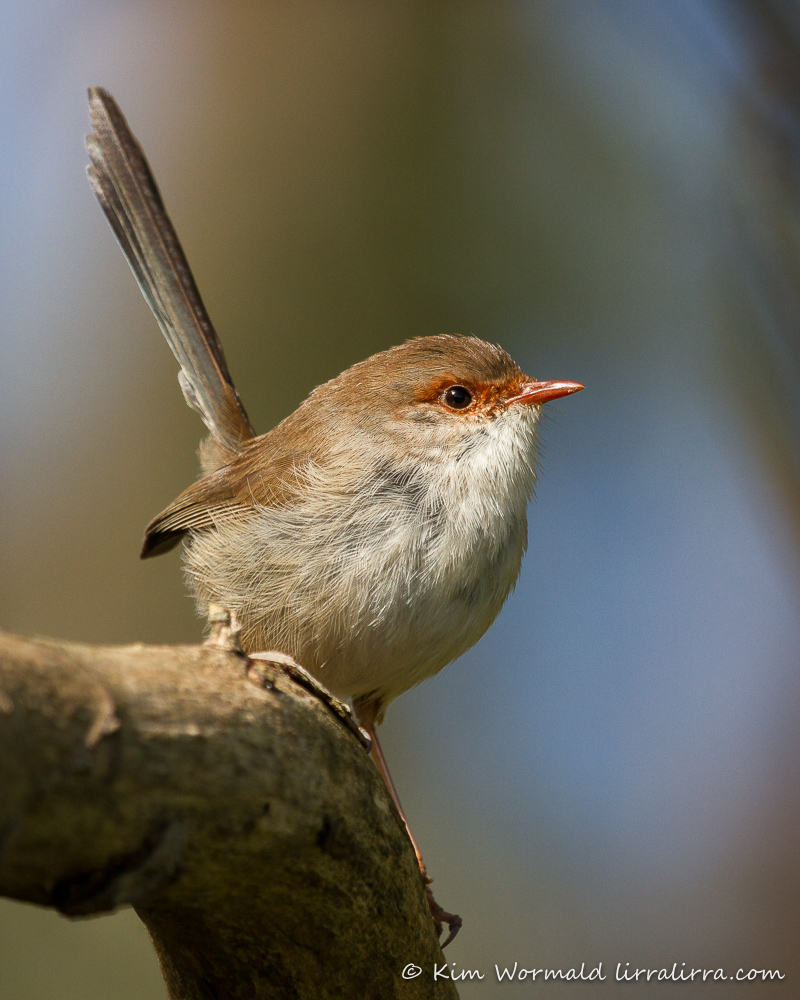I was asked recently whether I had any Superb Fairy-wren images that an artist could use as the basis for a painting. I sent a couple of dozen ‘possibles’ for consideration. The artist chose two, one of which is included among this week’s images. This set me wondering what criteria she was looking for, and which image I would choose (if only I could paint).
 Superb Fairy-wren (Malurus cyaneus)
Superb Fairy-wren (Malurus cyaneus)
1/640, f/5.6, ISO 200
I would be tempted to try the image above of the young male Superb Fairy-wren as I like his direct look, the tail position, how fluffed up he is and especially the way the wind is ruffling his feathers. Young male Superbs are often confused with females but they lack the orange coloured lores and orange feathers around the eye. As the males grow, their bill gradually turns from brown to black.
 Superb Fairy-wren (Malurus cyaneus)
Superb Fairy-wren (Malurus cyaneus)
1/640, f/5.6, ISO 200
The fairy-wren above is clearly a female. Her long leg stretch makes me smile and the background colours are very pleasing. Females can have varying amounts of blue in their tails.
 Superb Fairy-wren (Malurus cyaneus)
Superb Fairy-wren (Malurus cyaneus)
1/640, f/5.6, ISO 200
I like the perch in the image above and the way the fairy-wren stands out against the dark background. The curl of feathers on her rump is particularly cute as are the fluffy feathers of her underparts as they sweep up over her wing.
 Superb Fairy-wren (Malurus cyaneus)
Superb Fairy-wren (Malurus cyaneus)
1/640, f/5.6, ISO 200
This shot is of a male Superb Fairy-wren in breeding plumage, if you look closely you’ll be able to see the tiny bug in its bill. I like the graceful curves in this image.
 Superb Fairy-wren (Malurus cyaneus)
Superb Fairy-wren (Malurus cyaneus)
1/640, f/5.6, ISO 200
By now you’ll know, if you didn’t already, whether the fairy-wren above is male or female. These fairy-wrens often forage on the ground, searching for bugs among the grasses and leaf litter. I was lying on the grasses to take this shot and it looks as though the fairy-wren was a bit surprised to see me looking at her. I’d enjoy painting the setting in this image, it would be easier than painting the bird!
 Superb Fairy-wren (Malurus cyaneus)
Superb Fairy-wren (Malurus cyaneus)
1/640, f/5.6, ISO 200
I think the jaunty looking male above would be fun to paint as he poses on a banksia flower. I like the detail of the feathers fringing his throat and from his tail down to his leg. I also like the way his tail coverts frame his beautifully coloured tail.
Now I’m curious about which image others would choose.
Happy birding
Kim
~ thank you for visiting and commenting
~ if you would like to join the subscribers receiving a weekly email when lirralirra is updated, please use the ‘subscribe’ box above right

I’m happy for you with the pictures chosen by the artists. Can you take pictures of their work later ?
I most often use the 150-600 mm Sigma and my husband uses the 100-300.
Happy birding Kim.
Hugs
I am sent photographs of their artwork, and sometimes spoiled with printed cards 🙂
Wow! Just beautiful. That male on the thistle already is a work of art! That is so brilliant I would not draw it. I do some, artwork and like the others, detail definitely inspires me but also attitude. A bored bird is an awful painting. An alert, bird with attitude is my choice. I would do the last one. But I’d print the thistle one for my wall to appreciate every day!
Hi Judy, what a lovely thing to say about Thistle Wren! I felt so lucky to see it feeding there and to capture it on ‘film’. It’s not often that being so far behind with weeding proves to be so lucky. Now you’re the third person to mention those two images, that’s interesting.
I would LOVE to paint the one on the milk thistle with the little bug in his beak!!! Beautiful curves and perfect composition, lovely colours, I can already see how I’d paint it. If the artist didn’t choose the wren on the Thistle I would love permission to paint it and also do a lino cut print of it!
Detail is a big thing when choosing a photo to work off, I’ve seen lots of lovely photos but they often aren’t crisp and can’t be blown up to work from, your photos are perfect for artists to work from. I loved doing the Barking Owl and everyone comments on its eyes, but it is what it is because of your photo. 🙂 I often see photos on here that I’d love to paint! Your photos are all perfect!
Hi Amanda, you created a truly beautiful painting of the Barking Owl and I’m happy for you to work on the Thistle Wren. Please email me so you can tell me more about your ideas. Thank you for your kind comments, it’s nice for my pixel-peeping obsession to be so appreciated 🙂
It’s is à really beautiful species, male or female, both sexes have an atypical jizz. I love it. I love it.
To paint, the last picture is perfect if you want a dark background. The bird therefore takes the whole eye of the observer. Picture 4 is good too. The movement of the bird gives life to the photo and comes out in front of the light background.
Congratulations for this very beautiful collection! Thank you Kim
I have a question. Do you have a 500 mm or 600 mm?
See you soon and happy birding
Thanks for sharing your thoughts on the images Nath, you and Margot have agreed on your favourites. I often use a lens that is between those two. What do you use?
I love the 4th one, but I’d say let’s leave that as a photograph. It’s amazing.
I think the 6th one could be well portrayed at the hands of a skilled artist, with lots of scope to play with colour.
I’m glad you like that image Margot, thank you. There are now artists working on more than one of the images above, including a highly skilled artist working on image number 6. I will plan to share a photograph of the artworks when they are completed.
I think I would pick the last image to paint! Upright and alert, he looks too cute.
Hi Donna Dee, he does look very jaunty in that shot, and the lighting is especially nice and glowing.
Hi Kim As a painter always looking for detail, I love them all (of course), but I think I would choose the first one because the placement of the feet is wonderful. I really like to be able to see how the birds hold onto things and how this affects their whole posture. Of course the female doesn’t have the fantastic colour, but the feather detail here is absoutely wonderful for such small birds. Thank you so much for sharing, Kim
Thank you Kathy. That’s such an interesting rationale for the first bird. I adore the subtle. colouring of the females. Actually though, the first bird is a young male but it does look similar to a female.
Love them all Kim. I would find it difficult to single out any!
Me too Gai, I might end up with some kind of abstract medley
“superb” kim. i’d have to choose them all
I remember you doing a painting course a while ago, maybe you should have a go at painting a couple of them
Kim, Leah just maybe of help to you I’m sure she would love to be of help, she had done some commercial work ie: shower curtains etc
Please send me an email about this, it sounds interesting, thank you
Nature is a SUPERB artist, with magnificent galleries. IF I could paint (a big if) I suspect the first image would tug at my heartstrings and mind most.
You are so right about nature! For some reason I imagine that you would be a very good artist.
PS maybe because you are so aware of detail and composition, and colour